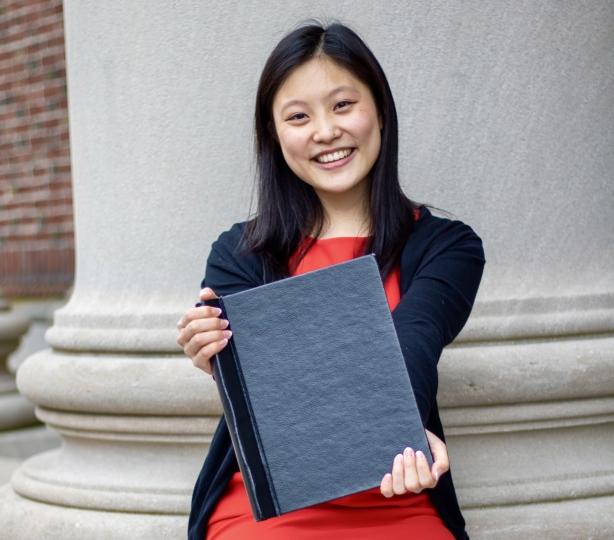Emily He, S.B. '22, developed a novel enzyme deliver platform for people with bleeding disorders for her senior capstone project. (Credit: Emily He)
Engineering Design Projects (ES 100), the capstone course at the Harvard John A. Paulson School of Engineering and Applied Sciences (SEAS), challenges seniors to engineer a creative solution to a real-world problem.
Engineering ultrasound-triggered red blood cell delivery of thrombin to induce targeted hemostasis
Emily He, S.B. ‘22, engineering sciences (bioengineering)
What did you do for your project?
Uncontrolled bleeding is associated with significant risk of illness and death. Risks are further increased in people with bleeding disorders, as they suffer from inefficient blood clotting. Thrombin is an enzyme critical to the blood clotting process, but the systemic delivery of thrombin to treat bleeding may result in lethal blood clots. This project engineers a novel, noninvasive, targeted form of thrombin delivery to induce hemostasis, which means the stopping of bleeding, for persons with bleeding disorders and/or surgical bleeding. More broadly, these strategies constitute a novel delivery platform that can be applied to other clotting factors, protein therapeutics, and small molecules.
How did you come up with this idea for your final project?
My research mentor, Dr. Sol Schulman, a hematologist-oncologist, is well-versed with the substantial human suffering associated with uncontrollable bleeding and lethal blood coagulation. Through many brainstorming sessions, we discussed possible drug delivery methods that would be both targeted and noninvasive. To address uncontrollable bleeding, we settled on using thrombin. Through literature search and discussions with Professor Samir Mitragotri and Dr. Linsey Moyer, we settled on using ultrasound-activated red blood cells as carriers.
What real-world challenge does this project address?
Current treatments, such as coagulation factor replacement therapy and hemostatic agents, can be effective in inducing hemostasis, but not in all patients. For instance, patients may develop inhibitors to the infused coagulation factor, neutralizing the factor before it functions. And hemostatic treatments tend to be systemic, increasing overall toxicity. There is a need for a targeted form of hemostasis that does not induce thrombosis.
How did your project come together over the course of the year?
The project ideation process took approximately two months, as my original project idea was purely a research project but needed to be an engineering design project. After many brainstorming and planning sessions, I dedicated around two months to learning how to make the red blood cell (RBC) carriers, three months for optimizing the creation process, then another three months for optimizing the ultrasound delivery. The last month was spent testing its efficacy in human plasma and compiling the data into presentation and report format.
What part of the project proved the most challenging?
Timing. As undergraduates, we all have a full course load and are involved with many extracurriculars. To spearhead a research project with time-sensitive experiments, I tested out many schedules and transportation methods to find a schedule that worked for me.
What part of the project did you enjoy the most?
I genuinely enjoyed the ideation and troubleshooting conversations I would have with my lab mates. Experiments inevitably go wrong, but through discussions and sharing ‘lessons learned’, we informally mentored each other and incorporated each other into our research community.
Also, there’s nothing quite like an experiment working!
What skills did you gain through your project?
Besides the many technical research skills, I learned how to present data – in figures and words – to make it interpretable to a wide scientific audience. I also gained a greater appreciation for the research community – although a senior thesis may seem like an individual project, it’s a joint effort with guidance and mentorship from my research lab, ES100, and many others.
Press Contact
Matt Goisman | mgoisman@g.harvard.edu
